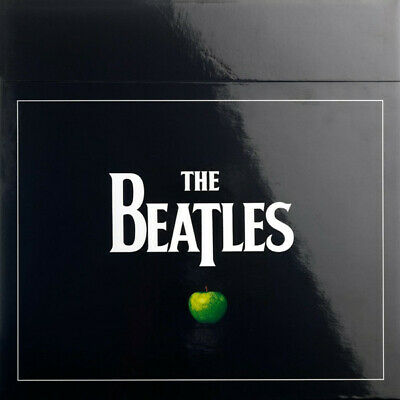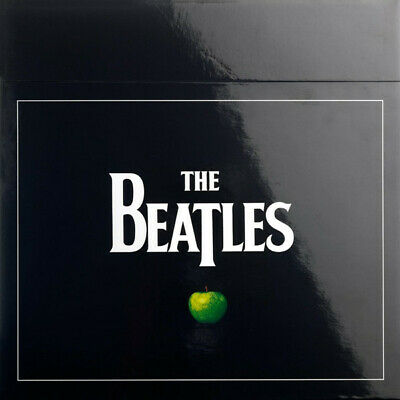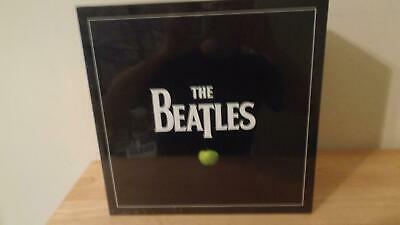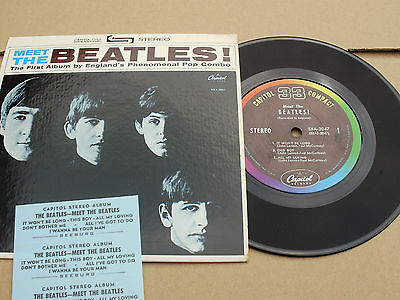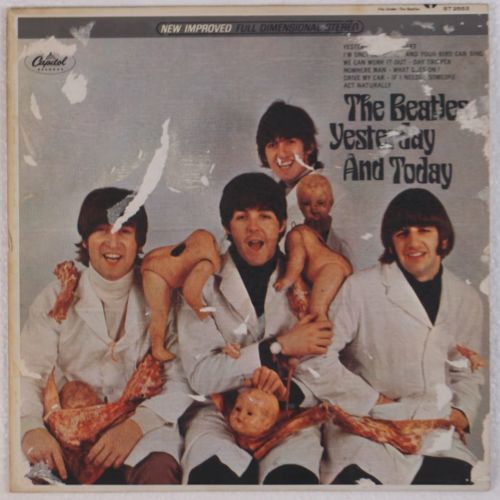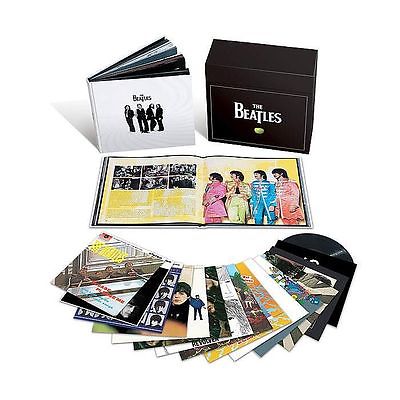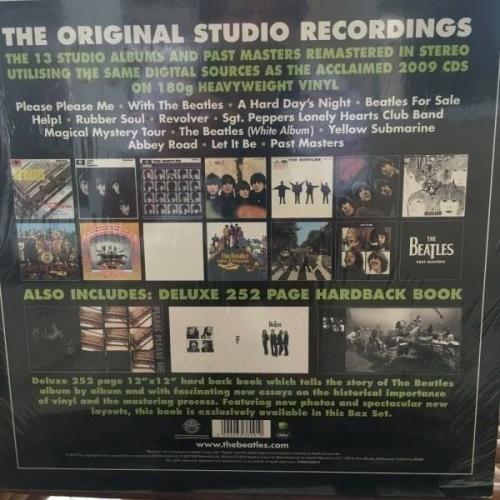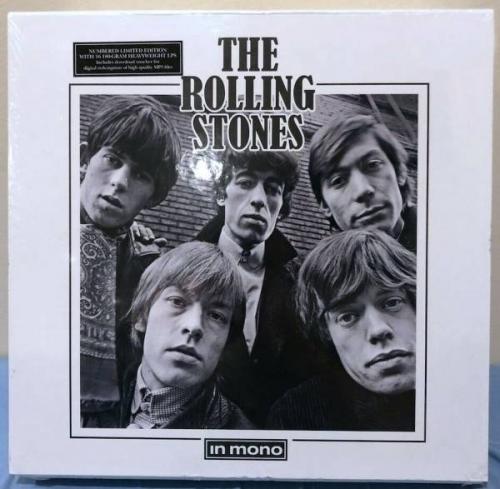Welcome to our listing, thanks very much for looking
See our own website We have lots of out of print LPs and CDs Find us on the web at -
hearthedifference.net
Please note that SHIPPING IS NOT FREE - we have discovered a new way to ship with full tracking and insurance, which is much less expensive but is still the same, high quality service than the post office, UPS, FEDEX, etc. You will receive 2 invoices...the first one is for the product you purchased, and then we will send you a separate PayPal invoice for the shipping cost of your order. Once paid, we will arrange to ship.
Please see our other listings - new items added almost daily.
To access our eBay store click on the little red door at the top right section of any of our eBay listings or, click on -
Background -
2013 Stereophile Magazine Record to Die For
TAS Rated 5/5 Music, 4/5 Sonics in the February 2013 Issue of The Absolute Sound
180-gram Vinyl LP Cut at Abbey Road Studios using the Non-Limited 24-bit Digital Masters Sourced from the Original Analog Master Tapes
The Beatles were an English rock band formed in Liverpool in 1960 and one of the most commercially successful and critically acclaimed acts in the history of popular music. The group s best-known lineup consisted of John Lennon rhythm guitar, vocals , Paul McCartney bass guitar, vocals , George Harrison lead guitar, vocals and Ringo Starr drums, vocals . Rooted in skiffle and 1950s rock and roll, the group later worked in many genres ranging from pop ballads to psychedelic rock, often incorporating classical and other elements in innovative ways. Their enormous popularity first emerged as Beatlemania as their songwriting grew in sophistication, by the late 1960s they came to be perceived by many fans and cultural observers as an embodiment of the ideals shared by the era s socio-cultural revolutions.
As a five-piece line-up of Lennon, McCartney and Harrison on guitar and vocals, with Stuart Sutcliffe bass and Pete Best drums , the band built their reputation playing clubs in Liverpool and Hamburg over a three-year period from 1960. Sutcliffe left the group in 1961, and Best was replaced by Starr the following year. Molded into a professional act by manager Brian Epstein, their musical potential was enhanced by the creativity of producer George Martin. They gained popularity in the United Kingdom after their first single, Love Me Do , became a modest hit in late 1962. They acquired the nickname the Fab Four as Beatlemania grew in Britain over the following year, and by early 1964 they had become international stars, leading the British Invasion of the United States pop market. The band toured extensively around the world until August 1966, when they performed their final commercial concert. From 1966 they produced what many critics consider to be some of their finest material, including the innovative and widely influential albums Revolver 1966 , Sgt. Pepper s Lonely Hearts Club Band 1967 , The Beatles 1968 and Abbey Road 1969 . After their break-up in 1970, the ex-Beatles each found success in individual musical careers. Lennon was murdered in 1980, and Harrison died of cancer in 2001. McCartney and Starr remain active.
The Beatles are the best-selling band in history, with sales of over one billion units estimated by EMI Records. They have had more number-one albums on the British charts and sold more singles in the UK than any other act. According to the RIAA, as of 2012 they have sold 177 million units in the US, more than any other artist, and in 2008 they topped Billboard magazine s list of the all-time most successful Hot 100 artists. As of 2012, they hold the record for most number-one hits on the Hot 100 chart with 20. They have received 7 Grammy Awards from the American National Academy of Recording Arts and Sciences, an Academy Award for Best Original Song Score and 15 Ivor Novello Awards from the British Academy of Songwriters, Composers and Authors. They were collectively included in Time magazine s compilation of the 20th century s 100 most influential people.
The Beatles catalog given the audiophile treatment 180 Gram Vinyl Pressings Cut at Abbey Road Studios using the Non-Limited 24-bit Digital Masters Sourced from the Original Analog Master Tapes
THE BEATLES ACCLAIMED STUDIO ALBUM REMASTERS ON 180-GRAM VINYL:
Pressed on 180-Gram, Audiophile Quality Vinyl with replicated artwork, The Beatles 14 albums return to their original glory No detail was spared, including the poster in The Beatles The White Album , the Sgt. Pepper s Lonely Heart Club Band s cutouts, and special inner bags for some of the titles. Each album is available individually, and accompanied by a stunning, elegantly designed 252-page hardbound book in a lavish boxed edition which is limited to 50,000 copies worldwide.
The book, exclusive to the boxed edition, is authored by award-winning radio producer Kevin Howlett and features a dedicated chapter for each of the albums, as well as insight into the creation of the remasters and how the vinyl albums were prepared. The 12 x12 book showcases a wealth of photographs spanning The Beatles recording career, including many images which were not included in the 2009 CD booklets.
The titles include The Beatles 12 original UK albums, first released between 1963 and 1970, the US-originated Magical Mystery Tour, now part of the group s core catalogue, and Past Masters, Volumes One Two, featuring non-album A-sides and B-sides, EP tracks and rarities. With this release, The Beatles first four albums make their North American stereo vinyl debuts. In 2013, the remastered albums will make their mono vinyl debuts.
Since it was recorded, The Beatles music has been heard on a variety of formats from chunky reel-to-reel tapes and eight-track cartridges to invisible computer files. But there has never been a more romantic or thrilling medium for music than a long-playing twelve-inch disc. We play records. The process of carefully slipping the disc out of the sleeve, cleaning it and lowering the stylus provides a personal involvement in the reproduction of the music.
When The Beatles albums were first released, the listener enjoyed a tangible relationship with the music in the grooves of a record. There was an emotional connection to the artifact carrying the sound, and this bond was strengthened by the LP sleeve. Rather than a merely functional object to protect the disc, it was elevated to a stylish accessory. Certainly, the cover of a Beatles album conveyed a message about the music it was wrapped around. For example, the dominant orange and brown hues and elongated faces on the front of Rubber Soul seem to embody the sound of the record. With the advent of the cassette tape in the seventies and the compact disc in the 1980s, album artwork was reduced in size and importance, losing much of its charm. That is partly why vinyl LPs have not, as predicted, been discarded.
None of that would really matter, were it not for the enduring power of The Beatles music. In September, 2009, The Beatles remastered albums on CD graced charts around the world. Seventeen million album sales within seven months was resounding evidence of the timeless relevance of their legacy. Through five decades, the music of The Beatles has captivated generation upon generation.
For producer Rick Rubin, surveying The Beatles recorded achievements is akin to witnessing a miracle. If we look at it by today s standards, whoever the most popular bands in the world are, they will typically put out an album every four years, Rubin said in a 2009 radio series interview. So, let s say two albums as an eight year cycle. And think of the growth or change between those two albums. The idea that The Beatles made thirteen albums in seven years and went through that arc of change... it can t be done. Truthfully, I think of it as proof of God, because it s beyond man s ability.
REMASTERING THE BEATLES ORIGINAL STUDIO ALBUMS FOR VINYL:
There has always been demand for The Beatles albums on vinyl. Indeed, 2011 s best-selling vinyl LP in the United States was Abbey Road. Following the success of The Beatles acclaimed, GRAMMY Award-winning 2009 CD remasters, it was decided that the sound experts at EMI s Abbey Road Studios should create new versions of The Beatles vinyl LPs. The project demanded the same meticulous approach taken for the CD releases, and the idea was a simple one: cut the digital remasters to vinyl with an absolute minimum of compromise to the sound. However, the process involved to do that was far from simple.
The first stage in transferring the sound of a master recording to vinyl is the creation of a disc to be used during vinyl manufacture. There were two options to consider. A Direct Metal Master DMM , developed in the late seventies, allows sound to be cut directly into a stainless steel disc coated with a hard copper alloy. The older, alternative method is to cut the sound into the soft lacquer coating on a nickel disc - the first of several steps leading to the production of a stamper to press the vinyl.
A blind listening test was arranged to choose between a lacquer or copper cut. Using both methods, A Hard Day s Night was pressed with ten seconds of silence at the beginning and end of each side. This allowed not only the reproduction of the music to be assessed, but also the noise made by the vinyl itself. After much discussion, two factors swung the decision towards using the lacquer process. First, it was judged to create a warmer sound than a DMM. Secondly, there was a practical advantage of having blank discs of a consistent quality when cutting lacquers.
The next step was to use the Neumann VMS80 cutting lathe at Abbey Road. Following thorough mechanical and electrical tests to ensure it was operating in peak condition, engineer Sean Magee cut the LPs in chronological release order. He used the 24-bit Digital Masters Sourced from the Original Analog Master Tapes rather than the 16-bit versions that were required for CD production. It was also decided to use the remasters that had not undergone limiting - a procedure to increase the sound level, which is deemed necessary for most current pop CDs.
Having made initial test cuts, Magee pinpointed any sound problems that can occur during playback of vinyl records. To rectify them, changes were made to the remasters with a Digital Audio Workstation. For example, each vinyl album was listened to for any sibilant episodes - vocal distortion that can occur on consonant sounds such as S and T. These were corrected by reducing the level in the very small portion of sound causing the undesired effect. Similarly, any likelihood of inner-groove distortion was addressed. As the stylus approaches the centre of the record, it is liable to track the groove less accurately. This can affect the high-middle frequencies, producing a mushy sound particularly noticeable on vocals. Using what Magee has described as surgical EQ, problem frequencies were identified and reduced in level to compensate for this.
The last phase of the vinyl mastering process began with the arrival of the first batches of test pressings made from master lacquers that had been sent to the two pressing plant factories. Stringent quality tests identified any noise or click appearing on more than one test pressing in the same place. If this happened, it was clear that the undesired sounds had been introduced either during the cutting or the pressing stage and so the test records were rejected. In the quest to achieve the highest quality possible, the Abbey Road team worked closely with the pressing factories and the manufacturers of the lacquer and cutting styli.
An additional and unusual challenge was to ensure the proper playback of the sounds embedded in the lock-groove at the end of side two of Sgt. Pepper s Lonely Hearts Club Band. Requiring a combination of good timing and luck, it had always been a lengthy and costly process to make it work properly. In fact, it was so tricky, it had never been attempted for American pressings of the LP. Naturally, Sean Magee and the team perfected this and the garbled message is heard as originally intended on the remastered Sgt. Pepper LP.
Highly-skilled technicians have worked long and hard to make The Beatles on vinyl sound better than ever. All we need to do is listen to the results of their dedicated labour on the remastered LPs. Handle with care. But most of all, enjoy the music.
Almost everyone...agree s that the 252-page book that comes with the set is the finest individual Beatle collectible yet devised. Whatever your convictions, this set is beyond essential. Gorgeously packaged and remastered with great care - don t be silly - this music is where the phrase to die for began - Robert Baird, Stereophile Magazine, February 2013, p. 62
The bass is tight, the highs are clear, and the recordings have consistent clarity... - Music 5/5, Sonics 4/5 - Greg Cahill, The Absolute Sound, February 2013, p. 134
The physical presentation of the box... qualifies as very good. The jewel is the 252-page book, offering an engaging overview of the Beatles history. The records themselves sport a mixture of Parlophone label, Capitol label, and Apple label IDs--a fun touch for those new to Beatlemania... - Jeff Dorgay, TONEAudio Magazine, No. 52, January 2013.
This listing is for a very rare, Boxed Set of 16-LPs - a FACTORY SEALED and assumed to be MINT condition set, PRESSED and ISSUED by CAPITOL, Parlophone, Apple Records of a highly collectible title from their catalog featuring the music of -
The Beatles
16-LP Box Set title -
The Beatles in STEREO
LP Listing:
LP01: Please Please Me PCS 3042, 1963 Parlophone
LP02: With The Beatles PCS 3045, 1963 Parlophone
LP03: A Hard Day s Night PCS 3058, 1964 Parlophone
LP04: Beatles for Sale PCS 3062, 1964 Parlophone
LP05: Help PCS 3071, 1965 1986 Parlophone
LP06: Rubber Soul PCS 3075, 1965 1986 Parlophone
LP07: Revolver PCS 7009, 1966 Parlophone
LP08: Sgt. Pepper s Lonely Hearts Club Band PCS 7027, 1967 Parlophone
LP09: Magical Mystery Tour 2835, 1967 Capitol
LP10: The Beatles White Album, PCS 7067-8, 1968 Apple
LP11: Yellow Submarine PCS 7070, 1966 1967 1969 Apple
LP12: Abbey Road PCS 7088, 1969 Apple
LP13: Let It Be PCS 7096, 1970 Apple
LP14: Past Masters SET 5099969943515, 5099968463915/5099968464011, 1962-1970, 1988 Parlophone/Apple
Performers / Credits / Other Information:
Phonographic Copyright p EMI Records Ltd.
Licensed To Apple Corps Ltd.
Manufactured By Capitol Records, LLC
Pressed By Rainbo Records
The Beatles vinyl stereo box set, 14 albums 2009, 2012
Manufactured in US Printed Pressed in US by Capitol Records
The Original Studio Recordings
The 13 Studio Albums and Past Masters remastered in stereo using the same digital sources as the acclaimed 2009 CDs on 180g Heavyweight Vinyl
Limited to 50,000 copies wordwide.
Editions contain original extras: Sgt. Pepper s cut-outs-sheet Magical Mystery Tour 24-page booklet White Album band member photographs and poster.
Past Masters contains 4-page 12 color info sheet
Also includes: Deluxe 252 page 12 x12 hardback book which tells the story of The Beatles album by album and with fascinating new essays on the historical importance of vinyl and the mastering process. featuring new photos and spectacular new layouts, this book is exclusively available in this Box Set.
Barcode Box Set : 5099963380910
All The Beatles s Stereo Albums Return to their Original Glory and details right down to the album poster in the White Album and the Sgt Pepper Cut-Outs:
Please Please Me - Love Me Do and P.S. I Love You are presented in mono North American LP debut in stereo
With The Beatles - North American LP debut in stereo
A Hard Day s Night - North American LP debut in stereo
Beatles For Sale - North American LP debut in stereo
Help - Features George Martin s 1986 stereo remix
Rubber Soul - Features George Martin s 1986 stereo remix
Revolver - Original album
Sgt. Pepper s Lonely Hearts Club Band - packaging includes replica psychedelic inner sleeve, cardboard cutout sheet and additional insert
Magical Mystery Tour - Packaging includes 24-page color book
The Beatles - Packaging includes double-sided photo montage / lyric sheet and 4 solo color photos
Yellow Submarine - Only a Northern Song is presented in mono. Additional insert includes original American liner notes
Abbey Road - Original album
Let It Be - Original album
Past Masters - Love Me Do original single version , She Loves You , I ll Get You , and You Know My Name Look Up the Number are presented in mono. Packaging, notes and photographic content is based on 2009 CD releaseThe 16-LP Boxed Set is from the rare Capitol / Parlophone / Apple Records series of LP Boxed Sets.
Catalog / UPC 5099963380910
LPs issued in 2012 on 180-gram vinyl
LP Box Set made in the USA limited edition
The LPs, OUTER BOX and INSERTS are all assumed to be in MINT
condition as this item is FACTORY SEALED
Comes complete - a superb collectible
This LP is an
audiophile quality pressing any collector of fine MFSL, half speeds,
direct to discs, Japanese/UK pressings etc., can attest to the
difference a quality pressing can make to an audio system .
Don t let this rarity slip by
